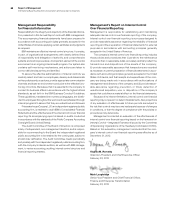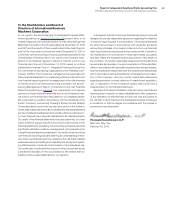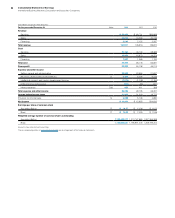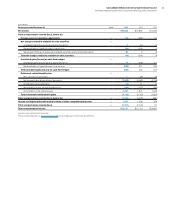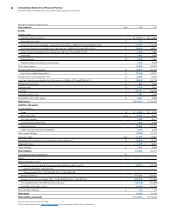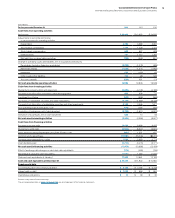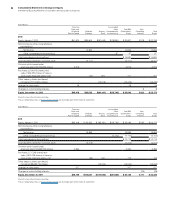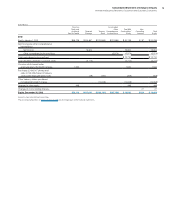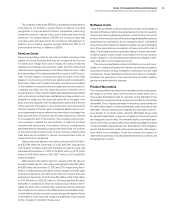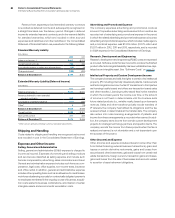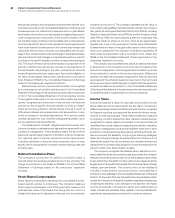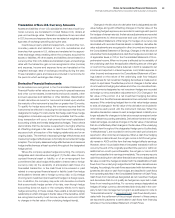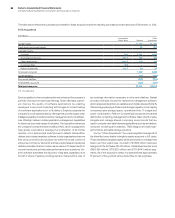IBM 2012 Annual Report Download - page 79
Download and view the complete annual report
Please find page 79 of the 2012 IBM annual report below. You can navigate through the pages in the report by either clicking on the pages listed below, or by using the keyword search tool below to find specific information within the annual report.78 Notes to Consolidated Financial Statements
International Business Machines Corporation and Subsidiary Companies
78
Hardware
The company’s hardware offerings include the sale or lease of
system servers, storage solutions, retail store systems and the sale
of semiconductors. The company also offers installation services
for its more complex products.
Revenue from hardware sales and sales-type leases is recog-
nized when risk of loss has transferred to the client and there are no
unfulfilled company obligations that affect the client’s final accep-
tance of the arrangement. Any cost of standard warranties and
remaining obligations that are inconsequential or perfunctory are
accrued when the corresponding revenue is recognized. Revenue
from rentals and operating leases is recognized on a straight-line
basis over the term of the rental or lease.
Software
Revenue from perpetual (one-time charge) license software is rec-
ognized at the inception of the license term if all revenue recognition
criteria have been met. Revenue from term (recurring license charge)
license software is recognized on a straight-line basis over the
period that the client is entitled to use the license. Revenue from
post-contract support, which may include unspecified upgrades on
a when-and-if-available basis, is recognized on a straight-line basis
over the period such items are delivered. In multiple-deliverable
arrangements that include software that is more than incidental to
the products or services as a whole (software multiple-deliverable
arrangements), software and software-related elements are accounted
for in accordance with software revenue recognition guidance.
Software-related elements include software products and services
for which a software deliverable is essential to its functionality. Tan-
gible products containing software components and non-software
components that function together to deliver the tangible product’s
essential functionality are not within the scope of software revenue
recognition guidance and are accounted for based on other appli-
cable revenue recognition guidance.
A software multiple-deliverable arrangement is separated into
more than one unit of accounting if all of the following criteria are met:
• The functionality of the delivered element(s) is not dependent
on the undelivered element(s);
• There is vendor-specific objective evidence (VSOE) of fair
value of the undelivered element(s). VSOE of fair value is based
on the price charged when the deliverable is sold separately
by the company on a regular basis and not as part of the
multiple-deliverable arrangement; and
• Delivery of the delivered element(s) represents the culmination
of the earnings process for that element(s).
If any one of these criteria is not met, the arrangement is accounted
for as one unit of accounting which would result in revenue being
recognized ratably over the contract term or being deferred until the
earlier of when such criteria are met or when the last undelivered
element is delivered. If these criteria are met for each element and
there is VSOE of fair value for all units of accounting in an arrange-
ment, the arrangement consideration is allocated to the separate
units of accounting based on each unit’s relative VSOE of fair value.
There may be cases, however, in which there is VSOE of fair value
of the undelivered item(s) but no such evidence for the delivered
item(s). In these cases, the residual method is used to allocate the
arrangement consideration. Under the residual method, the amount
of consideration allocated to the delivered item(s) equals the total
arrangement consideration less the aggregate VSOE of fair value of
the undelivered elements.
The company’s multiple-deliverable arrangements may have
a stand-alone software deliverable that is subject to the existing
software revenue recognition guidance. The revenue for these
multiple-deliverable arrangements is allocated to the software deliv-
erable and the non-software deliverables based on the relative
selling prices of all of the deliverables in the arrangement using the
hierarchy: VSOE, third-party evidence (TPE) or best estimate of sell-
ing price (BESP). In the limited circumstances where the company
cannot determine VSOE or TPE of the selling price for all of the
deliverables in the arrangement, including the software deliverable,
BESP is used for the purpose of performing this allocation.
Financing
Financing income attributable to sales-type leases, direct financing
leases and loans is recognized on the accrual basis using the effec-
tive interest method. Operating lease income is recognized on a
straight-line basis over the term of the lease.
Best Estimate of Selling Price
In certain limited instances, the company is not able to establish
VSOE for all elements in a multiple-deliverable arrangement. When
VSOE cannot be established, the company attempts to establish
the selling price of each element based on TPE. TPE is determined
based on competitor prices for similar deliverables when sold
separately.
When the company is unable to establish selling price using
VSOE or TPE, the company uses BESP in its allocation of arrange-
ment consideration. The objective of BESP is to determine the price
at which the company would transact a sale if the product or service
were sold on a stand-alone basis. Due to the fact that the company
sells its products and services on a stand-alone basis, and therefore
has established VSOE for its products and services offerings, the
company uses BESP to determine the relative selling price for a
product or service in a multiple-deliverable arrangement on an infre-
quent basis. An example of when BESP would be used is when the
company sells a new product, for which VSOE and TPE does not
yet exist, in a multiple-deliverable arrangement prior to selling the
new product on a stand-alone basis.


